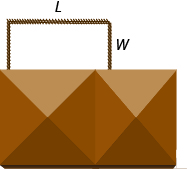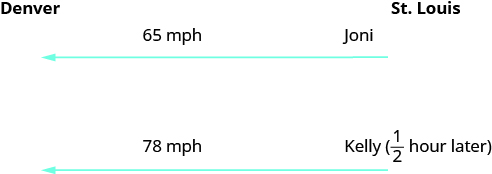| << Chapter < Page | Chapter >> Page > |
Translate to a system of equations and then solve:
Two angles are supplementary. The measure of the larger angle is 12 degrees more than three times the smaller angle. Find the measures of the angles.
The angle measures are 42 degrees and 138 degrees.
Translate to a system of equations and then solve:
Two angles are supplementary. The measure of the larger angle is 18 less than twice the measure of the smaller angle. Find the measures of the angles.
The angle measures are 66 degrees and 114 degrees.
Translate to a system of equations and then solve:
Randall has 125 feet of fencing to enclose the rectangular part of his backyard adjacent to his house. He will only need to fence around three sides, because the fourth side will be the wall of the house. He wants the length of the fenced yard (parallel to the house wall) to be 5 feet more than four times as long as the width. Find the length and the width.
| Step 1. Read the problem. | |
| Step 2. Identify what you are looking for. | We are looking for the length and width. |
 | |
| Step 3. Name what we are looking for. | Let
the length of the fenced yard.
the width of the fenced yard |
| Step 4. Translate into a system of equations. | One length and two widths equal 125. |
 | |
| The length will be 5 feet more than four times the width. | |
 | |
| The system is:
Step 5. Solve the system of equations by substitution. |
 |
| Substitute
L = 4
W + 5 into the first
equation, then solve for W . |
 |
 | |
 | |
| Substitute 20 for
W in the second
equation, then solve for L . |
 |
 | |
 | |
 | |
|
Step 6. Check the answer in the problem.
|
|
| Step 7. Answer the equation. | The length is 85 feet and the width is 20 feet. |
Translate to a system of equations and then solve:
Mario wants to put a rectangular fence around the pool in his backyard. Since one side is adjacent to the house, he will only need to fence three sides. There are two long sides and the one shorter side is parallel to the house. He needs 155 feet of fencing to enclose the pool. The length of the long side is 10 feet less than twice the width. Find the length and width of the pool area to be enclosed.
The length is 60 feet and the width is 35 feet.
Translate to a system of equations and then solve:
Alexis wants to build a rectangular dog run in her yard adjacent to her neighbor’s fence. She will use 136 feet of fencing to completely enclose the rectangular dog run. The length of the dog run along the neighbor’s fence will be 16 feet less than twice the width. Find the length and width of the dog run.
The length is 60 feet and the width is 38 feet.
We used a table to organize the information in uniform motion problems when we introduced them earlier. We’ll continue using the table here. The basic equation was D = rt where D is the distance travelled, r is the rate, and t is the time.
Our first example of a uniform motion application will be for a situation similar to some we have already seen, but now we can use two variables and two equations.
Translate to a system of equations and then solve:
Joni left St. Louis on the interstate, driving west towards Denver at a speed of 65 miles per hour. Half an hour later, Kelly left St. Louis on the same route as Joni, driving 78 miles per hour. How long will it take Kelly to catch up to Joni?
A diagram is useful in helping us visualize the situation.

|
Identify and name what we are looking for.
A chart will help us organize the data. We know the rates of both Joni and Kelly, and so we enter them in the chart. |
|
| We are looking for the length of time Kelly,
k , and Joni, j , will each drive. Since we can fill in the Distance column. |
 |
|
Translate into a system of equations.
To make the system of equations, we must recognize that Kelly and Joni will drive the same distance. So, Also, since Kelly left later, her time will be hour less than Joni’s time. So, | |
| Now we have the system. |
 |
| Solve the system of equations by substitution. |
 |
| Substitute into the second equation, then solve for j . |
 |
 | |
 | |
 | |
| To find Kelly’s time, substitute j = 3 into the first equation, then solve for k . |
 |
 | |
 | |
|
Check the answer in the problem.
Joni 3 hours (65 mph) = 195 miles. Kelly hours (78 mph) = 195 miles. Yes, they will have traveled the same distance when they meet. |
|
| Answer the question. | Kelly will catch up to Joni in
hours.
By then, Joni will have traveled 3 hours. |

Notification Switch
Would you like to follow the 'Elementary algebra' conversation and receive update notifications?